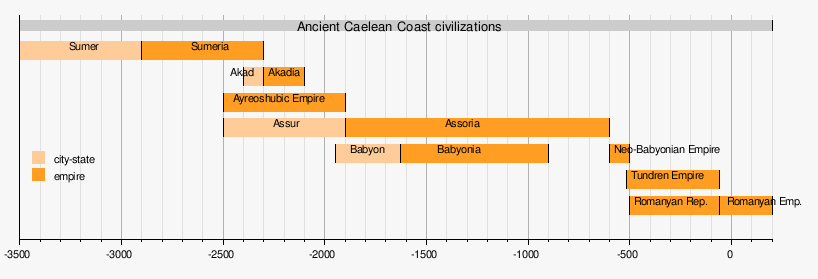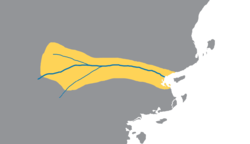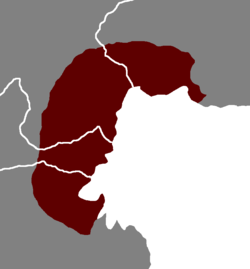Ancient Caelean Coast
| The Ancient Caelean Coast |
|---|
 |
| Regions and states |
| Archaeological periods |
| Languages |
| Literature |
| Mythology |
The ancient Caelean Coast was the home of early civilizations on the coast of the Caelean Sea, which in modern times makes up the north eastern coast of Greater Sacramento, the eastern coasts of Terranihil and Kavarda, and in some cases the south western coast of Quebecshire.
Contents
Timeline
- Bronze age (4500-1000 BCE)
- Sumeria (4500-2300 BCE)
- Old Alaqa (3000-2350 BCE)
- Akadia (2300–2100 BCE)
- Ayreoshubic Empire (2500-1900 BCE)
- Second Alaqa (1900-)
- Old Assoria (1900-1580 BCE)
- Old Babylonia (1950-1600 BCE)
- Middle Babylonia (1600-1000 BCE)
- Iron Age (1300-600 BCE)
- Middle Assorian Empire (1580-900 BCE)
- Neo-Assorian Empire (900-600 BCE)
- Neo-Babylonian Empire (600-500 BCE)
- Classical antiquity (600 BCE-680 CE)
- Tundren Empire (500-60 BCE)
- Romanyan Empire (60 BCE-680 CE)
Sumeria
Sumeria, located along the Alaius River, is one of the earliest known civilizations in the world. It lasted from its establishment c. 4500 BCE until the rise of Akadia in the 2300 BCE. The Sumerians were one of the first people to have utilized a writing system, Sumerian cuneiform, which they used for Sumerian.
Old Alaqa
Old Alaqa was established c. 3000 BCE until it was conquered by the Ayreoshubic Kingdom in 2350 BCE. It originated south of Zahjeddah. Alaqan hieroglyphs date back to 3000 BCE.
Akadia
The Akadian Empire, founded by Sargon the Great, lasted from the 2300 to 2100 BCE until it was conquered by the Ayreoshubic Empire. It is regarded as one of the world's first empires.
Ayreoshubic Empire
The Ayreoshubic Empire which originated c. 2500 BCE became the most prominent civilization on the Caelean coast. The Ayreoshubic alphabet was derived from Alaqan hieroglyphs and used to write the Ayreoshubic language, the predecesor language to the Ayreoshubic languages.
The Ayreoshubic Empire had conquered lands north of it in modern day southern Quebecshire and south of it in Alaia (eastern Terranihil) by 2300 BCE. It captured even more southern lands, including Judea and Alaqa, by 2200 BCE. It then began an inland campaign and defeated the Akadian Empire in 2100, becoming the undisputed power of the Ancient Calean Coast for two centuries.
The Ayreoshubic Empire collapsed in 1900 BCE for a multitude of reasons. The collapse led to migrations throughout Ecros. The Empire's already widespread influence due to military might and extensive trade networks was further expanded with these migrations. Ayreoshubic daughter languages developed in modern day Quebecshire and Greater Sacramento, and reached Sur. The Ayreroshubic script also pread and developed into other scripts. Multiple civilizations succeeded the fractured empire, including Assoria and Babylonia.
Second Alaqa
Alaqa immediately succeeded the Ayreoshubic Kingdom north eastern Greater Sacramento from c. 1900 BCE. The Alaqan people continued to speak Alaqan, however they adopted their new Alaqan script derived from the Ayreoshubic script.
Assoria
Assoria was a city-state established c. 2500 BCE. Its people spoke the Assorian dialect of Akadian. It was under Sumerian, then Akadian, and then Ayreoshubic rule until 1900 BCE. The Old Assorian Kingdom succeeded the Ayreoshubic Empire in Alaia and was a powerful nation until when it was conquered by Babylonia in 1630 BCE. Babylonian rule only lasted about fifty years. In 1580 BCE, Assoria regained independence and is considered the Middle Assorian Empire. The Middle period lasted until 900 BCE when Assoria conquered Babylonia, which began the Neo-Assorian Empire. Assoria was overthrown and replaced by he Neo-Babylonian Empire in 600 BCE.
Babylonia
Babylonia emerged as a city-state in 1950 BCE. Babylonia under its first dynasty (Old Babylonia) was the rival of Old Assoria. It conquered Assoria and many neighboring regions in 1800 and ruled them until 1750. Babylonia went into decline following the death of Hammurabi. At the same time that Assoria left its dark age, Babylonia came to be ruled by the Kassite dynasty and also entered a time of relative prosperity. In 1000 BCE, Babylonia entered a period of chaos in which their was no clear king. Babylonia was conquered by the Neo-Assorian Empire in 900. After three centuries of Assorian rule, the Babylonian revolt led to the overthrow of the Assorians and the establishment of the Neo-Babylonian Empire. This empire was the last natively ruled empire in Alaia. The Tundren Empire conquered Alaia in 500 BCE.
Tundren Empire
Around 1000 BCE, the Kavardans settled the woodlands and plains northeast of the Sadical mountains, in the region later named Kavarda. In the 7th century BCE, Tundre arose and defeated neighboring civilizations, including the Neo-Babylonian Empire. The Tundren Empire was one of the largest empires since the Ayreoshubic Empire.
The Tundren Empire built several road systems from Kavarda to Alaia. The Empire officially used Aramaic as the lingua franca to communicate with its linguistically diverse inhabitants.
The Caelean Coast, along with the Tundren Empire's provinces, was conquered by the Romanyan Empire in the 1st century BCE. The empire then collapsed with the dynasty only remaining in control of Kavarda for a short while longer.


